Study of the Heat Exhaust Coefficient of Lateral Smoke Exhaust in Tunnel Fires: The Effect of Tunnel Width and Transverse Position of the Fire Source
Abstract
:1. Introduction
2. Theoretical Analysis
3. Numerical Modeling
3.1. Model Design
3.2. Simulated Conditions
4. Results and Discussion
4.1. Effect of Tunnel Width on Fire Plume without Smoke Exhaust
4.2. Effect of Fire Source Transverse Location on Heat Exhaust Coefficient
4.3. Verification of the Effect of Lateral Extraction Efficiency
5. Conclusions
Author Contributions
Funding
Institutional Review Board Statement
Informed Consent Statement
Data Availability Statement
Acknowledgments
Conflicts of Interest
References
- Zhang, F.; Gao, Y.; Wu, Y.; Wang, Z. Face stability analysis of large-diameter slurry shield-driven tunnels with linearly increasing undrained strength. Tunn. Undergr. Space Technol. 2018, 78, 178–187. [Google Scholar] [CrossRef]
- Xu, Z.S.; Liu, Q.L.; He, L.; Tao, H.W.; Zhao, J.M.; Chen, H.G.; Li, L.J.; Fan, C.G. Study on the heat exhaust coefficient and smoke flow characteristics under lateral smoke exhaust in tunnel fires. Fire Mater. 2019, 43, 857–867. [Google Scholar] [CrossRef]
- Yao, Y.Z.; Li, Y.Z.; Ingason, H.; Cheng, X.D. Numerical study on overall smoke control using naturally ventilated shafts during fires in a road tunnel. Int. J. Therm. Sci. 2019, 140, 491–504. [Google Scholar] [CrossRef]
- Yao, Y.Z.; He, K.; Peng, M.; Shi, L.; Cheng, X.D.; Zhang, H.P. Maximum gas temperature rise beneath the ceiling in a portals-sealed tunnel fire. Tunn. Undergr. Space Technol. 2018, 80, 10–15. [Google Scholar] [CrossRef]
- Beard, A.N. Fire safety in tunnels. Fire Saf. J. 2009, 44, 276–278. [Google Scholar] [CrossRef]
- Fan, C.G.; Ji, J.; Sun, J.H. Influence of longitudinal fire location on smoke characteristics under the tunnel ceiling. Fire Mater. 2015, 39, 72–84. [Google Scholar] [CrossRef]
- Zhang, X.; Xu, Z.S.; Ni, T.X.; Peng, J.Z.; Zeng, J.W.; Ran, Q.B. Investigation on smoke temperature distribution in a double-deck tunnel fire with longitudinal ventilation and lateral smoke extraction. Case Stud. Therm. Eng. 2019, 13, 100375. [Google Scholar] [CrossRef]
- Xu, Z.S.; Zhao, J.M.; Liu, Q.L.; Chen, H.G.; Liu, Y.H.; Geng, Z.Y.; He, L. Experimental investigation on smoke spread characteristics and smoke layer height in tunnels. Fire Mater. 2019, 43, 303–309. [Google Scholar] [CrossRef]
- Wang, Y.F.; Sun, X.F.; Liu, S.; Yan, P.N.; Qin, T.; Zhang, B. Simulation of back-layering length in tunnel fire with vertical shafts. Appl. Therm. Eng. 2016, 109, 344–350. [Google Scholar] [CrossRef]
- Fan, C.G.; Chen, J.; Mao, Z.L.; Zhou, Y.; Mao, S.H. A numerical study on the effects of naturally ventilated shaft and fire locations in urban tunnels. Fire Mater. 2019, 43, 949–960. [Google Scholar] [CrossRef]
- Fan, C.G.; Chen, J.; Zhou, Y.; Liu, X.P. Effects of fire location on the capacity of smoke exhaust from natural ventilation shafts in urban tunnels. Fire Mater. 2018, 42, 974–984. [Google Scholar] [CrossRef]
- Chen, L.F.; Hu, L.H.; Zhang, X.L.; Zhang, X.Z.; Zhang, X.C.; Yang, L.Z. Thermal buoyant smoke back-layering flow length in a longitudinal ventilated tunnel with ceiling extraction at difference distance from heat source. Appl. Therm. Eng. 2015, 78, 129–135. [Google Scholar] [CrossRef]
- Ingason, H.; Li, Y.Z. Model scale tunnel fire tests with longitudinal ventilation. Fire Saf. J. 2010, 45, 317–384. [Google Scholar] [CrossRef]
- Yang, J.; Pan, X.H.; Hua, M. Study on the Flow-dynamic Characterization of the Lateral Mechanical extraction system in tunnel fire. Procedia Eng. 2018, 211, 888–896. [Google Scholar] [CrossRef]
- Jiang, X.P.; Jin, J.; Wang, Z.Y.; Chen, X.G. A simple dimensionless model for the confinement velocity of the lateral concentrated smoke exhaust in tunnel fire. Tunn. Undergr. Space Technol. 2022, 122, 104368. [Google Scholar] [CrossRef]
- Zhong, W.; Sun, C.P.; Bian, H.T.; Gao, Z.H.; Zhao, J. The plug-holing of lateral mechanical exhaust in subway station: Phenomena, analysis, and numerical verification. Tunn. Undergr. Space Technol. 2021, 112, 103914. [Google Scholar] [CrossRef]
- Zhu, Y.T.; Tang, F.; Huang, Y.J. Experimental study on the smoke plug-holing phenomenon and criteria in a tunnel under the lateral smoke extraction. Tunn. Undergr. Space Technol. 2022, 121, 104330. [Google Scholar] [CrossRef]
- Liu, Q.L.; Xu, Z.S.; Fan, C.G.; Tao, H.W.; Zhao, J.M.; He, L. Experimental and numerical study of plug-holing with lateral smoke exhaust in tunnel fires. Fire Technol. 2022, 1, 1–21. [Google Scholar] [CrossRef]
- Takeuchi, S.; Aoki, T.; Tanaka, F.; Moinuddin, K.A. Modeling for predicting the temperature distribution of smoke during a fire in an underground road tunnel with vertical shafts. Fire Saf. J. 2017, 91, 312–319. [Google Scholar] [CrossRef]
- Ingason, H.; Li, Y.Z.; Lönnermark, A. Tunnel Fire Dynamics; Springer: Berlin, Germany, 2014. [Google Scholar]
- Hinkley, P.L. The flow of hot gases along an enclosed shopping mall a tentative theory. Fire Saf. Sci. 1970, 807, 1–17. [Google Scholar]
- Ji, J.; Zhong, W.; Li, K.Y.; Shen, X.B.; Zhang, Y.; Huo, R. A simplified calculation method on maximum smoke temperature under the ceiling in subway station fires. Tunn. Undergr. Space Technol. 2011, 26, 490–496. [Google Scholar] [CrossRef]
- Cong, H.Y.; Wang, X.S.; Zhu, P.; Jiang, T.H.; Shi, X.J. Experimental study of the influences of board size and position on smoke extraction efficiency by natural ventilation through a board-coupled shaft during tunnel fires. Appl. Therm. Eng. 2018, 128, 614–624. [Google Scholar] [CrossRef]
- Hong, L.J.; Liu, C.J. Review of research on tunnel fire safety. Chin. J. Underg. Space Eng. 2005, 1, 149–154. [Google Scholar]
- Ji, J.; Tan, T.T.; Gao, Z.H.; Wan, H.X.; Zhu, J.P.; Ding, L. Numerical investigation on the influence of length–width ratio of fire source on the smoke movement and temperature distribution in tunnel fires. Fire Technol. 2019, 55, 963–979. [Google Scholar] [CrossRef]
- Ji, J.; Gao, Z.H.; Fan, C.G.; Sun, J.H. Large Eddy Simulation of stack effect on natural smoke exhausting effect in urban road tunnel fires. Int. J. Heat Mass Transf. 2013, 66, 531–542. [Google Scholar] [CrossRef]
- Ji, J.; Fan, C.G.; Zhong, W.; Shen, X.B.; Sun, J.H. Experimental investigation on influence of different transverse fire locations on maximum smoke temperature under the tunnel ceiling. Int. J. Heat Mass Transf. 2012, 55, 4817–4826. [Google Scholar] [CrossRef]

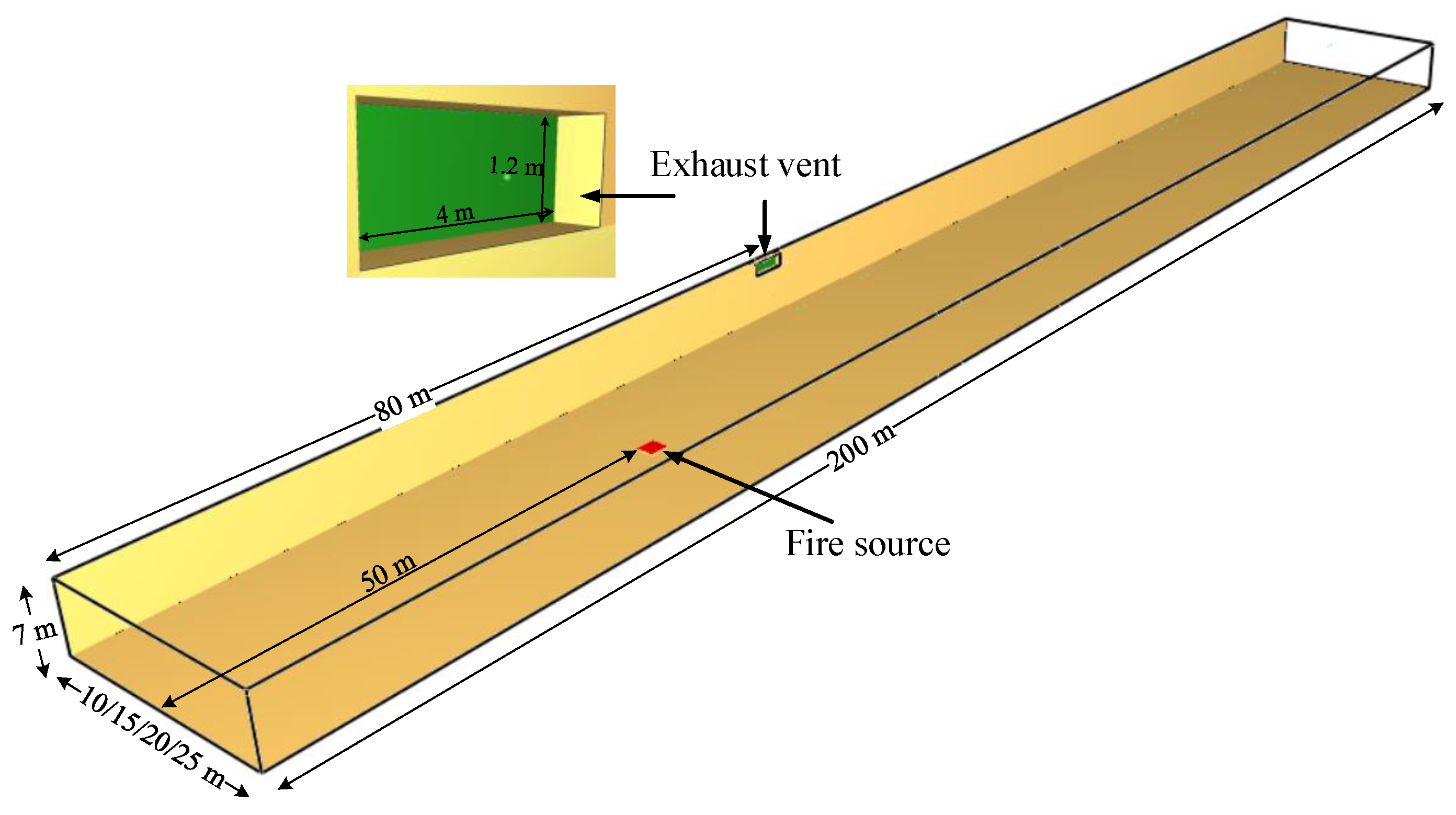



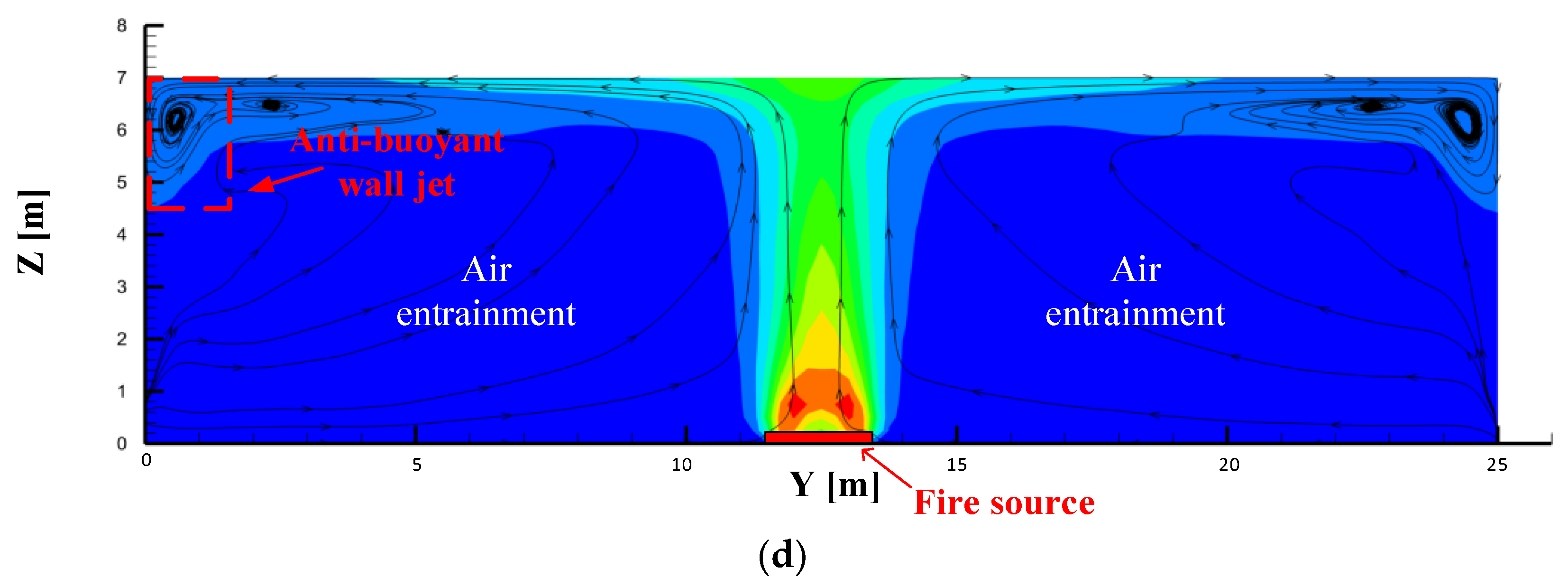
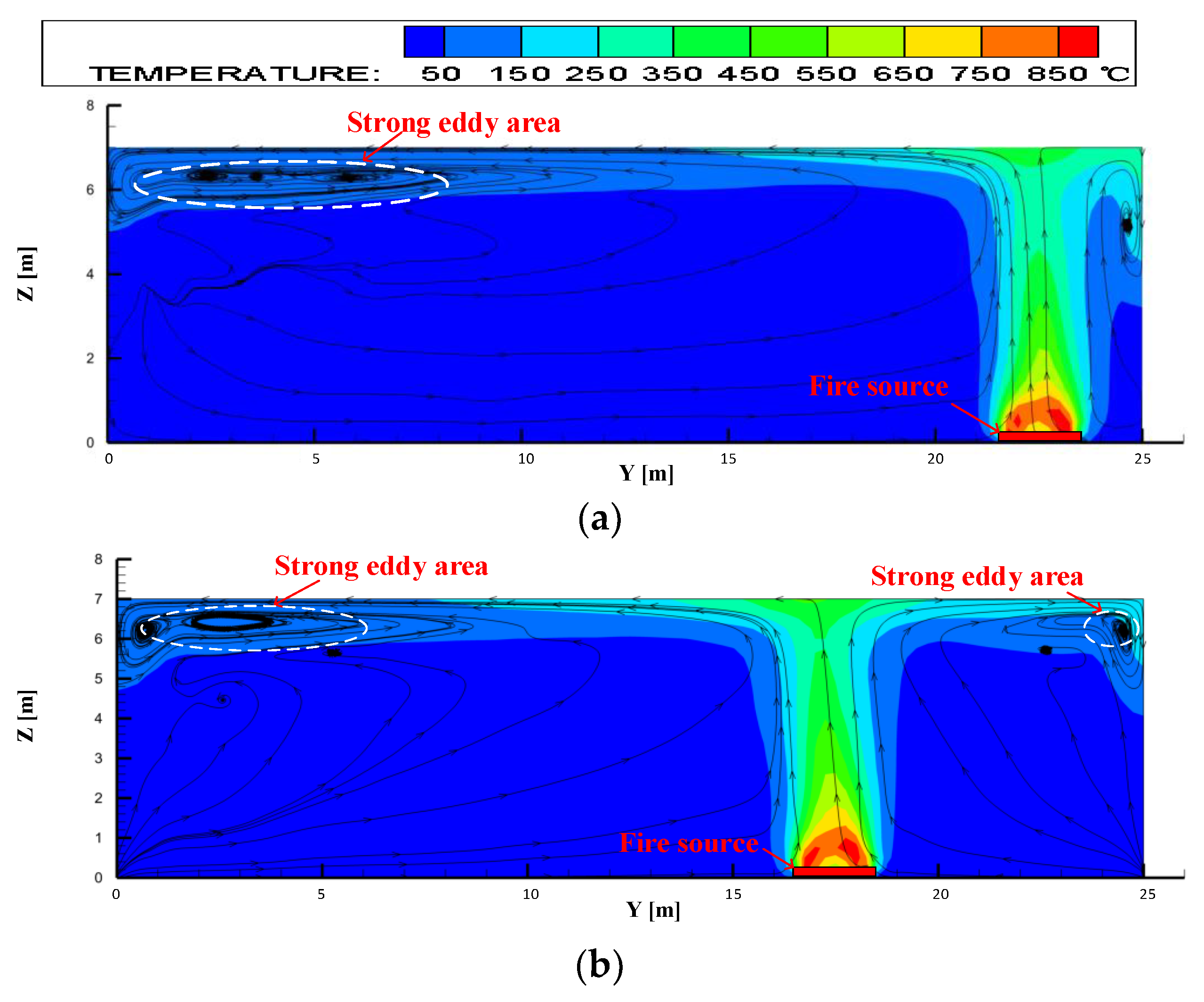

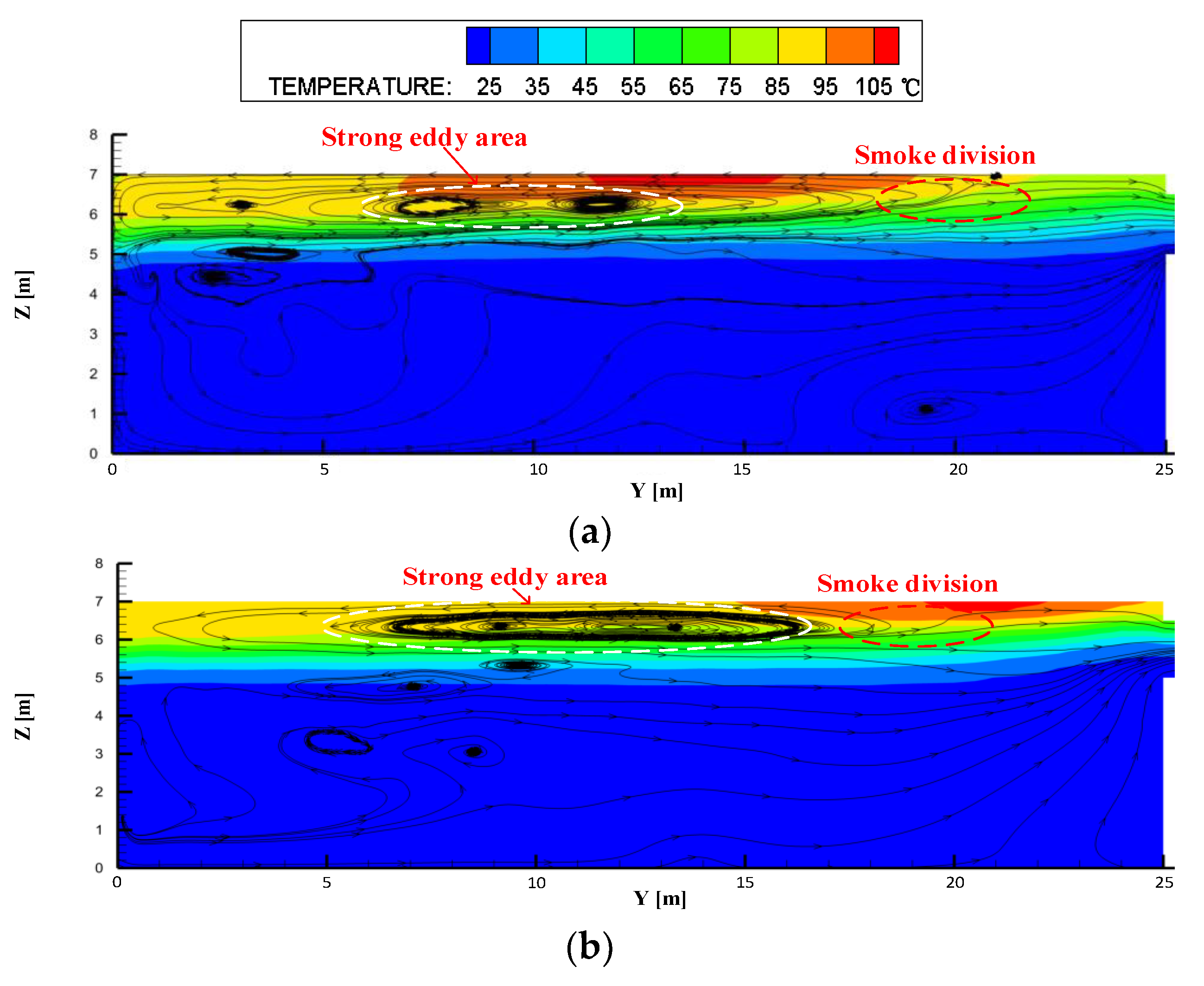

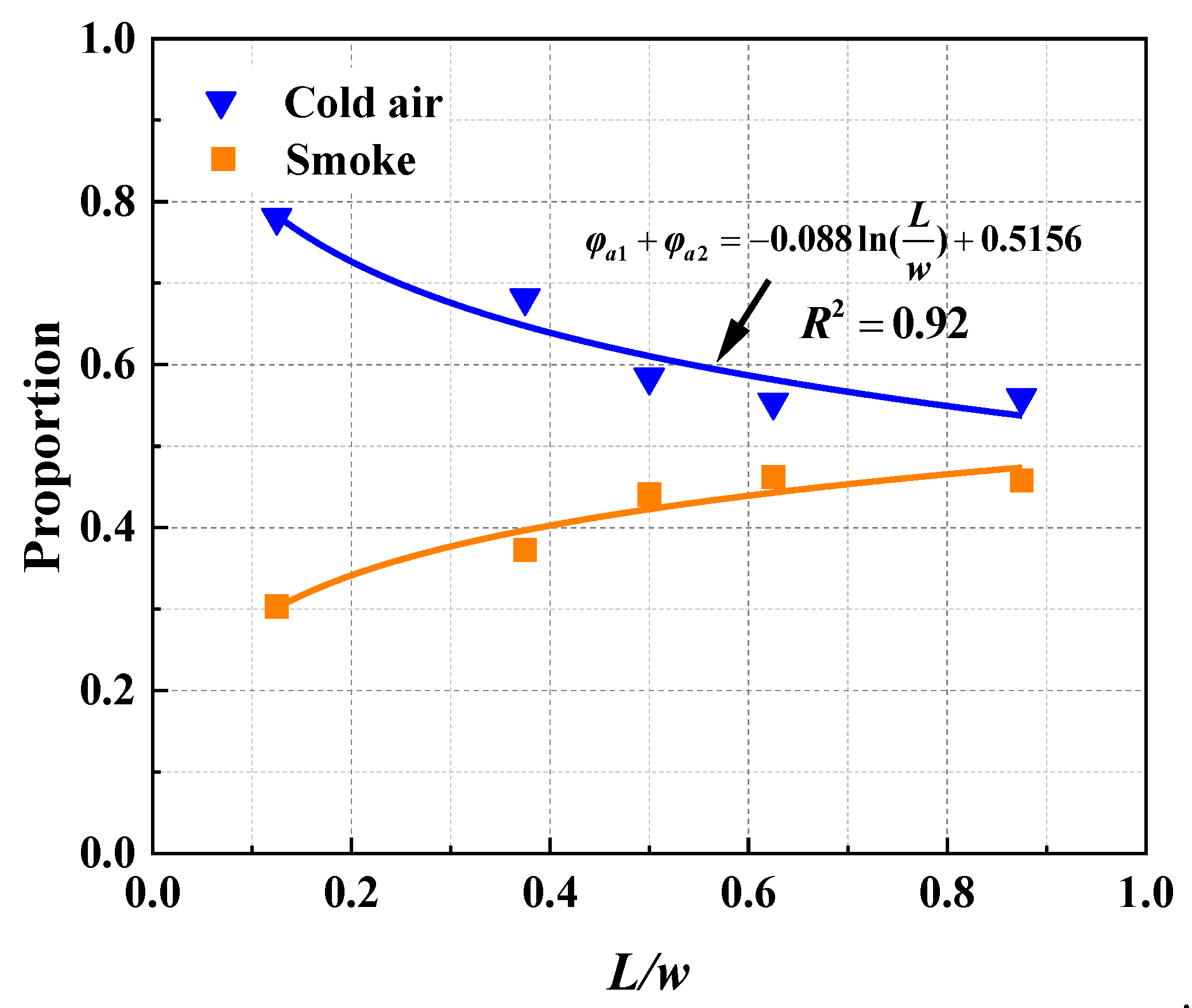

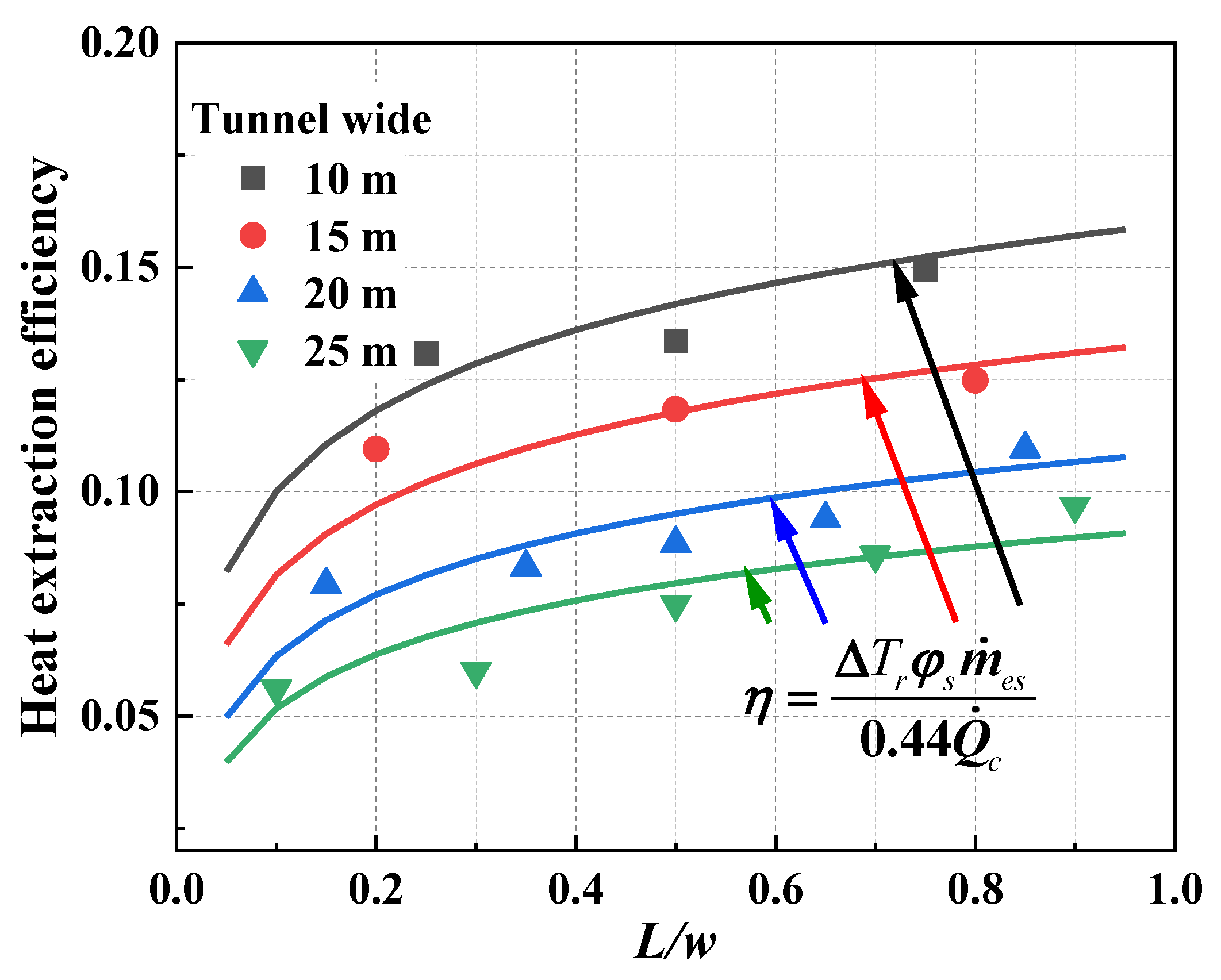
| NO. | HRR (MW) | Mass Flow Rate of the Exhaust Vent (kg/s) | Width of the Tunnel (m) | Transverse Distance between Fire Source and Side Wall (m) |
|---|---|---|---|---|
| 1–3 | 12 | 0 | 10 | 2.5, 5, 7.5 |
| 4–6 | 15 | 2.5, 7.5, 12.5 | ||
| 7–11 | 20 | 2.5, 7.5, 10, 12.5, 17.5 | ||
| 12–16 | 25 | 2.5,7.5, 12.5, 17.5, 22.5 | ||
| 17–19 | 12 | 10 | 2.5, 5, 7.5 | |
| 20–22 | 15 | 2.5, 7.5, 12.5 | ||
| 23–27 | 20 | 2.5, 7.5, 10, 12.5, 17.5 | ||
| 28–32 | 25 | 2.5,7.5, 12.5, 17.5, 22.5 |
Publisher’s Note: MDPI stays neutral with regard to jurisdictional claims in published maps and institutional affiliations. |
© 2022 by the authors. Licensee MDPI, Basel, Switzerland. This article is an open access article distributed under the terms and conditions of the Creative Commons Attribution (CC BY) license (https://creativecommons.org/licenses/by/4.0/).
Share and Cite
Liu, Q.; Xu, Z.; Xu, W.; Tagne, S.M.S.; Tao, H.; Zhao, J.; Ying, H. Study of the Heat Exhaust Coefficient of Lateral Smoke Exhaust in Tunnel Fires: The Effect of Tunnel Width and Transverse Position of the Fire Source. Fire 2022, 5, 167. https://doi.org/10.3390/fire5050167
Liu Q, Xu Z, Xu W, Tagne SMS, Tao H, Zhao J, Ying H. Study of the Heat Exhaust Coefficient of Lateral Smoke Exhaust in Tunnel Fires: The Effect of Tunnel Width and Transverse Position of the Fire Source. Fire. 2022; 5(5):167. https://doi.org/10.3390/fire5050167
Chicago/Turabian StyleLiu, Qiulin, Zhisheng Xu, Weikun Xu, Sylvain Marcial Sakepa Tagne, Haowen Tao, Jiaming Zhao, and Houlin Ying. 2022. "Study of the Heat Exhaust Coefficient of Lateral Smoke Exhaust in Tunnel Fires: The Effect of Tunnel Width and Transverse Position of the Fire Source" Fire 5, no. 5: 167. https://doi.org/10.3390/fire5050167







